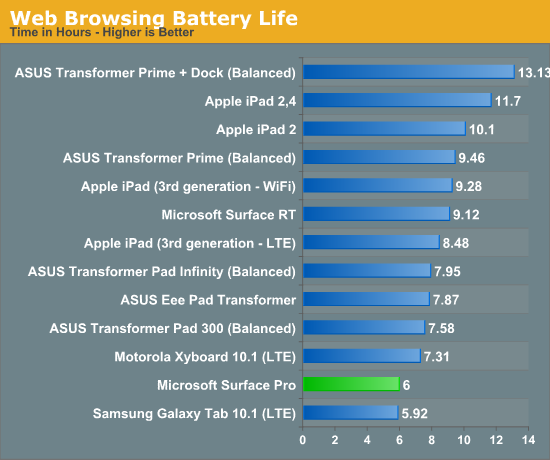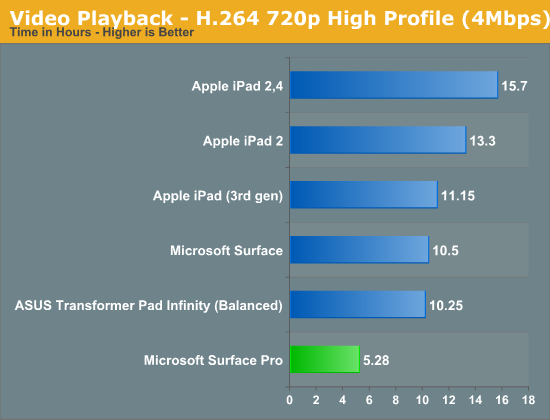Microsoft Surface Pro Review
by Anand Lal Shimpi on February 5, 2013 9:00 PM ESTBattery Life: The Downside
Despite having an integrated 42 Wh battery (similar in size to the 3rd and 4th gen iPads with Retina Display), battery life is a real sore spot for Surface Pro. Haswell is really designed to drive platform power down to very low levels, which should help close the gap between ARM/Atom based tablets and Core based tablets. Unfortunately, Haswell for tablets won’t hit until the third quarter of this year, which forced Microsoft to use Ivy Bridge.
In our tablet benchmarks, I never saw Surface Pro break the 6 hour mark on a single charge. In most cases I’d expect to see 5 - 6 hours out of Surface Pro in light, tablet usage. Video playback was especially disappointing as Surface Pro managed to use more power here than during our web browsing battery life test. I suspect this might have to do with the relative power efficiency of Ivy Bridge's video decoder. It'll be interesting to see how Haswell does in this department.


I also put Surface Pro through some of our new notebook battery life tests for 2013, and here it didn’t fare too bad. I only have Acer’s 13-inch S7 to compare to but Microsoft managed 3.85 hours in our medium workload compared to sub-3 hours for the larger Ultrabook:
| Windows 8 Notebook Battery Tests | ||
| Battery Test | Acer Aspire S7 (13-inch) | Microsoft Surface Pro |
| AnandTech 2013 Light | 4.00 hours | 5.2 hours |
| AnandTech 2013 Medium | 2.88 hours | 3.85 hours |
This is easily the biggest disappointment with Surface Pro. You just won’t get the all day battery life you do with an ARM based tablet out of this design. I expect Microsoft will have a solution to this problem with Haswell, but not until the end of the year.
Charging
Surface Pro retains the same large, magnetic power connector as Surface RT. In fact, Surface RT’s power adapter will still charge Surface Pro. The Pro model does however come with its own 48W adapter. It’s a nice looking, but large and still fairly traditional two piece power supply (brick + detachable wall cable). There’s no sophisticated cable management other than a tiny hook to help keep the device end of the cable together. One neat feature is the power adapter does feature an integrated USB port for charging your smartphone.
Under max charging load the power supply will draw around 27W at the wall. Microsoft included a 48W unit in order to be able to charge and power the device without slowing down charge time. It took me 2.692 hours to charge Surface Pro from completely empty to 100% with no additional power draw at the wall. The quick charge time is pretty nice and about the only reprieve here when talking about Surface Pro's battery.
I did notice something odd with the first power supply Microsoft sent me. When charging through my power meter, I picked up some interference in the capacitive touch screen itself resulting in around 10% of my taps not being recognized. Microsoft supplied another power supply that seemed to resolve the issue.













228 Comments
View All Comments
Mumrik - Wednesday, February 6, 2013 - link
I'm pretty sure Anandtech's core demographic wants all the details possible.pfroo40 - Wednesday, February 6, 2013 - link
The depth and detail of reviews on Anandtech are precisely why I read them. If I want biased and superficial reviews there are plenty of tech sites I can go to.vision33r - Tuesday, February 5, 2013 - link
In the Post PC Era today, majority of folks don't really need a high spec tablet. Most work is done by an app that's touch friendly and easy to use. Folks are getting by with an ARM based tablet for general web duties.It's tough to price something for this much productivity while most folks don't really need the power.
A $200 used iPad is sufficient for most folks to do light web, Facebook, and email.
Very tough to justify such a device for media consumption.
Fleeb - Tuesday, February 5, 2013 - link
"Apple has remained curiously quiet on this front, but I suspect that too will change in good time."karasaj - Tuesday, February 5, 2013 - link
That has nothing to do with Surface Pro... imo. More really criticism designed at the pricing of Surface RT, or possibly Atom based W8 tablets. Surface Pro is essentially analogous to the MBA.c4v3man - Wednesday, February 6, 2013 - link
An iPad is a joke, especially at $200+ for a used first gen. While it works, so does their Pentium 2 400Mhz pc running windows 98.Anything else in the 200 price range is going to far exceed the real life performance of an iPad. And they'll have a warranty. And a non-replaceable battery that is suffering at this age.
Spunjji - Friday, February 8, 2013 - link
Sadly, because Apple products hold their value well irrespective of actual worth, they hold their value well irrespective of actual worth. See how it works?Arsynic - Wednesday, February 6, 2013 - link
This device isn't aimed at consumers but rather productivity folks. My boss would love one of these. Physicians and nurses would love this.Surface RT (when it has more apps--in time) will suffice for everyone else.
Death666Angel - Wednesday, February 6, 2013 - link
Just a guess, but I'd say that most physicians and nurses would be fine with lighter, non-fan Atom Win8 platforms. I can't imagine their programs needing the horse power of a Core i5. :)cknobman - Wednesday, February 6, 2013 - link
Not really.Atom cpu power is starting to approach the realm of tolerable but Intel still neuters the platform with abysmal graphics.
So no Atom Win8 platforms (centered around a touch driven graphical interface) are not going to cut it.
We attempted to try that at my workplace and the Atom platforms were quickly tossed out in favor of Core platforms.